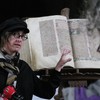Photo courtesy of HBO
Game of Thrones, HBO's massively popular fantasy series, is catching flak again. Despite the addition of supporting cast members over the past few seasons, actor David Oyelowo recently criticized the show's lack of diverse main characters, saying there was "no excuse" for it. "Even if for whatever reason," he continued, "it's a world in which people of color in those stories are subservient, or they are more in a helper role, that doesn't mean they can't have prominent storylines."I agree with Oyelowo, and as a medievalist, I'd go further in saying that, by not including people of color in major roles, author George R.R. Martin is creating a whiter medieval world than our own ever was.Though medieval ideas about race differ from modern definitions, medieval European history and literature are full of what we would today call people of color. Sometimes they play supporting roles, but other times, they're the main characters. In medieval European religious literature and belief, both St. Maurice and Balthazar were depicted as black Africans. Maurice was eventually named the patron saint of the Holy Roman Empire; medieval churches and cathedrals across Germany, Switzerland, and France were dedicated to him, and wealthy lords lavished funds on paintings of Balthazar in scenes of the Adoration of the Magi.But Spain wasn't the only hotspot of cultural exchange in medieval Europe: Italy was more diverse than most would imagine, too. The Emirate of Sicily lasted only a few hundred years, but with Italian, Greek, Arab, and Berber cultural, ethnic, and racial heritage, one would be hard-pressed to find a more multicultural place than medieval Sicily. Other parts of Italy were plenty diverse, too: Venetians worked as far afield as the eastern coast of the Black Sea and Damascus, injecting a taste for Far Eastern culture into Italian crafts. In one Italian silk woven in the 1300s, an Annunciation scene features the angel Gabriel, Mary, and the dove—in the form of a Chinese phoenix.Considering all this, it's not surprising that Alessandro de Medici, who for a time was the Duke of Florence and the head of the great Medici family, may have been mixed race. (We don't know for sure if his mother was black, Berber, Arab, or none of these, but we can now see why people in his era thought it was possible that he had north African heritage, since other Italians did.)Whether they wanted to or not, people just didn't stay put in the Middle Ages any more than they do today, which partially highlights how common slavery was in parts of medieval Europe—not just limited to certain places, as it is in Meereen and the other Ghiscari cities in Game of Thrones. In fact, slavery meant different things in different medieval cultures, although it always meant being unfree. A slave might have been a prisoner of war, or sold himself or herself to pay off a debt. In the Mamluk Sultanate, the ruling class, the Mamluks themselves were freed slaves. Any race of person could become enslaved: In the early Middle Ages, Vikings raided almost the entire Spanish coast, as well as much of the North African coastline; however, they also traded as far south and east as Baghdad. In the 800s, Vikings took black slaves in North African cities before selling them in northern Europe, and Vikings sold northern European slaves in the Middle East, too. In the 1200s, an Englishman was looking for his missing Ethiopian slave; by the later Middle Ages, both wealthy Italians and Turks were buying slaves from the Caucasus.Our 21st-century world is more multicultural than the European Middle Ages, in part due to the expansion of European peoples into the Americas and Asia that began toward the end of the Middle Ages. People of many modern races search carefully for traces of our heritages in that earlier world.Yet Martin has gone on record claiming that the series's historicized setting does not allow for main characters of color and stating firmly that the books are the books and the show is the show. Will showrunners David Benioff and D.B. Weiss find a medievalist to consult this season? They could also just listen to Oyelowo, who says that limiting characters of color to supporting roles "highlight[s] the inequality of storylines." Because we all deserve a chance to see ourselves center stage.Follow Kathleen E. Kennedy on Twitter.
Advertisement
Retaining a popularity that extends to the present day, Arthurian literature celebrates the great deeds of black knights and Berber or Arabic knights along as their white brothers in arms. Though his adventures vary in different traditions, the "Saracen" (Muslim) knight Sir Palomides is an important character who is renowned for his chivalry and converts to Christianity only late in life.Historically speaking, medieval Europe was a multiracial, multiethnic place; in our world, the Dornish didn't stay in Dorne, nor the Dothraki in their desert. In the 700s, a Berber army crossed the Straits of Gibraltar and took over almost all of what we would today call Spain. While the borders of al-Andalus, or Muslim Spain, shrank over the centuries, the Emirate of Granada was not toppled until 1492. For nearly 800 years, Spain was profoundly multiracial and connected to places like Syria, Egypt, Libya, and Morocco. Even the Christian kingdoms of Castile and Aragon were multiracial—and they continued as such while Portugal conquered territory in north and west Africa.Historically speaking, there's just no way around it—medieval Europe was a multiracial, multiethnic place.
Advertisement
